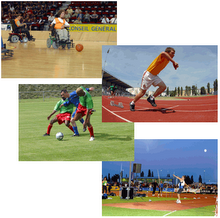

The most common type of ankle injury is a sprain. A sprain is stretching and tearing of ligaments (fibrous bands connecting adjacent bones in a joint.) There are many ligaments around the ankle and these can become damaged when the ankle is forced into a postion not normally encountered.
The most frequently seen sprain occurs when weight is applied to a foot which is on an uneven surface, and the foot "rolls in" (inversion). Because the sole of the foot is pointing inward as force is applied, the ligaments stabilizing the lateral - or outside - part of the ankle are stressed. Many patients report hearing a "snap" or "pop" at the time of the injury. This is usually followed by pain and swelling on the lateral aspect of the ankle.
The most frequently seen sprain occurs when weight is applied to a foot which is on an uneven surface, and the foot "rolls in" (inversion). Because the sole of the foot is pointing inward as force is applied, the ligaments stabilizing the lateral - or outside - part of the ankle are stressed. Many patients report hearing a "snap" or "pop" at the time of the injury. This is usually followed by pain and swelling on the lateral aspect of the ankle.
THE MOST IMPORTANT INITIAL MANAGEMENT OF A SPRAIN IS,,
R - rest
I - ice
C - compression
E - elevation
I - ice
C - compression
E - elevation
Many of the problems resulting from sprains are due to blood and edema in and around the ankle. Minimizing swelling helps the ankle heal faster. The RICE regimen facilitates this.
Rest - no weight bearing for the first 24 hours after the injury (Possibly longer, depending upon severity)
Ice - apply ice packs using a towel over a plastic bag to the area that is painful. Be careful to avoid frostbite. Ice should be intermittantly applied for the first 24 hours.
Compression - an ACE bandage or other soft elastic material should be applied to the ankle to help prevent the accumulaton of edema.
Elevation - elevating the ankle helps in removing edema. By having the foot higher than the hip (or heart), gravity is used to pull edema out of the ankle.
In the initial 24 hours, it is very important to avoid things which might increase swelling.
Avoid
hot showers
heat rubs (methylsalicylate counterirritants such as "Ben Gay", etc..
hot packs
drinking alcohol
aspirin - prolongs the clotting time of blood and may cause more bleeding into the ankle. (Tylenol or Ibuprofen may be taken to help with pain, but will not speed up the healing process)
Rest - no weight bearing for the first 24 hours after the injury (Possibly longer, depending upon severity)
Ice - apply ice packs using a towel over a plastic bag to the area that is painful. Be careful to avoid frostbite. Ice should be intermittantly applied for the first 24 hours.
Compression - an ACE bandage or other soft elastic material should be applied to the ankle to help prevent the accumulaton of edema.
Elevation - elevating the ankle helps in removing edema. By having the foot higher than the hip (or heart), gravity is used to pull edema out of the ankle.
In the initial 24 hours, it is very important to avoid things which might increase swelling.
Avoid
hot showers
heat rubs (methylsalicylate counterirritants such as "Ben Gay", etc..
hot packs
drinking alcohol
aspirin - prolongs the clotting time of blood and may cause more bleeding into the ankle. (Tylenol or Ibuprofen may be taken to help with pain, but will not speed up the healing process)
WHEN TO SEEK MEDICAL ATTENTION
If the ankle is obviously fractured or dislocated, then medical attention should be sought immediately. If you are fairly certain that it is sprained then use the RICE regimen and get a professional opinion regarding diagnosis and treatment. Rice University students are encouraged to make an appointment with one of the physicians at the student health service to assess the severity of the injury, determine if X-rays are necessary, and to receive instruction on proper rehabilitation of the injury.
In some instances a fracture of one of the bones in the leg or ankle may occur along with a sprain. Pain alone is not necessarily a reliable guide of the presence or absence of a fracture. Fractures can usually be diagnosed with an X-ray examination.
A student who spains his or her ankle on a Friday night can usually follow the RICE regimen, and see a physician on Monday or Tuesday.
Because it is not possible to predict or discuss every possible situation that might arise, it is recommended that the student use common sense in dealing with his or her injury.
DEGREE OF SEVERITY OF ANKLE SPAINS
If the ankle is obviously fractured or dislocated, then medical attention should be sought immediately. If you are fairly certain that it is sprained then use the RICE regimen and get a professional opinion regarding diagnosis and treatment. Rice University students are encouraged to make an appointment with one of the physicians at the student health service to assess the severity of the injury, determine if X-rays are necessary, and to receive instruction on proper rehabilitation of the injury.
In some instances a fracture of one of the bones in the leg or ankle may occur along with a sprain. Pain alone is not necessarily a reliable guide of the presence or absence of a fracture. Fractures can usually be diagnosed with an X-ray examination.
A student who spains his or her ankle on a Friday night can usually follow the RICE regimen, and see a physician on Monday or Tuesday.
Because it is not possible to predict or discuss every possible situation that might arise, it is recommended that the student use common sense in dealing with his or her injury.
DEGREE OF SEVERITY OF ANKLE SPAINS
Grade I - stretch and/or minor tear of the ligament without laxity (loosening)
Grade II - tear of ligament plus some laxity
Grade III - complete tear of the affected ligament (very loose)
Grade II - tear of ligament plus some laxity
Grade III - complete tear of the affected ligament (very loose)
TREATMENT
After the initial 24 hours the patient can begin partial weight bearing using crutches. Gradually progressing to full weight bearing over several days as tolerated. The patient should try to use a normal heel-toe gait. An ankle brace may be necessary to protect the joint from reinjury. As soon as pain allows, rehabilitation exercises should be done.
THE REHABILITATION EXERCISES ARE THE MOST IMPORTANT ASPECT OF RECOVERING FULL FUNCTION OF THE ANKLE.
A full list of exercises is availble at the student health service. One simple exercise that can be begun early in the course of treatment is the "alphabet" exercise. This is non weight bearing and involves trying to draw the letters of the alphabet with your toes.
Most spains heal completely within a few weeks. The more severe the injury, the longer the time to heal. Often it is necessary to continue rehab exercises for a month or two following the injury. Grade III injuries are usually managed conservatively - rehabilitation exercises, etc. - but a small percentage may require surgery.
Most spains heal completely within a few weeks. The more severe the injury, the longer the time to heal. Often it is necessary to continue rehab exercises for a month or two following the injury. Grade III injuries are usually managed conservatively - rehabilitation exercises, etc. - but a small percentage may require surgery.

















Hiç yorum yok:
Yorum Gönder